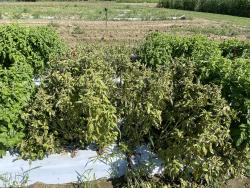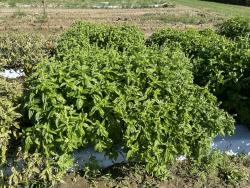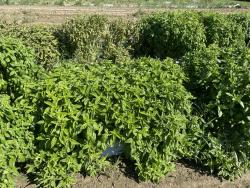The experiment was conducted at the University of Massachusetts Research and Education Farm in Deerfield, MA in a field with soil classified as a Hadley silt loam. Basil seeds were sown on 23 May in the greenhouse in 72-cell flats with 3 seeds per cell, and were moved outside to harden off on 26 Jun. Prior to bed formation, soil was amended with 130, 104, and 78 lbs/A of N, P, and K, respectively, in the form of Kreher’s pelleted chicken manure (5-4-3), in accordance with soil test results and recommendations from the UMass Soil Testing Lab. Raised beds were formed and covered with 1-mil white-on-black plastic mulch with one line of 6’ Flow Control (TORO) irrigation tape beneath.
Seedlings were planted by hand into the beds on 30 Jun. Plots consisted of 3 bed-ft with 2 rows of basil planted at 8-inch in-row spacing. Plots had 8 plants each and there were 2-ft unplanted buffers between plots within the bed. Plots were arranged in a randomized complete block design. Seedlings were watered in with drip irrigation at the time of planting, and subsequent irrigation was not needed due to excessive rainfall during the season. Weeds between the beds were controlled by hand and with tractor implements. Average monthly temperatures (°F) were 75.0 in July, 69.9 in August, and 65.9 in September. Rainfall (in.) was 11.54 in July, 3.87 in August, and 6.85 in September.
Downy mildew (DM) severity was assessed by visually assessing plants using the following 5-point scale: 0 = 0%; 1 = 5-25%; 2 = 30-50%; 3 = 55-75%; 4 = >75%. Ratings were made on 11, 18, and 25 Jul, 1, 8, 18, 22, and 29 Aug, and 5, 12, 19, and 26 Sep. A Kruskal-Wallis test (using PROC NPAR1WAY, SAS 9.4, SAS Institute, Cary, NC) was used to analyze these non-parametric data, followed by a Bonferroni-Dunn test to separate means at an alpha level of 0.05 adjusted for multiple comparisons.
Downy mildew was first observed on 18 Aug, on ‘Nufar’, ‘Sweet Aroma II’, ‘BA141’, and ‘Dolly’. Three weeks later, on 5 Sep, ‘BA140’, ‘BA141’, and ‘Prospera PS5’ still had no downy mildew, and ‘Prospera DMR’, ‘Evi’, and ‘BA141’ had significantly lower disease than ‘Nufar’, ‘Sweet Aroma II’, and ‘Dolly’. After another two weeks, on 19 Sep, all cultivars had some level of downy mildew; ‘Prospera DMR’ had significantly lower disease severity than all other varieties, followed by ‘BA140’, ‘Giuletta’, and ‘BA141’ and ‘Prospera PS5’. By the last rating date on 26 Sep, all cultivars had disease severity ratings above 55%.
|
Table 1. Downy mildew severityz |
||||
|
Variety |
5-Sep |
19-Sep |
||
|---|---|---|---|---|
| Prospera DMR | 0.25 | b | 0.67 | a |
| Prospera PS5 | 0.00 | a | 1.67 | d |
| Nufar | 4.00 | d | 4.00 | f |
| Sweet Aroma II | 4.00 | d | 4.00 | f |
| Evi | 0.25 | b | 2.00 | e |
| Giuletta | 0.00 | a | 1.67 | c |
| BA140 | 0.00 | a | 1.00 | b |
| BA141 | 1.00 | c | 1.67 | d |
| Dolla | 4.00 | d | 4.00 | f |
| p-value | <0.0001 | 0.0074 | ||
| zNon-parametric data were analyzed using a Kruskal-Wallis test (PROC NPAR1WAY) and means were separated using a Bonferroni-Dunn test at an alpha level of 0.05 adjusted for multiple comparisons. Numbers within each column followed by the same letter are not significantly different from each other. | ||||
Click on each photo to enlarge.







